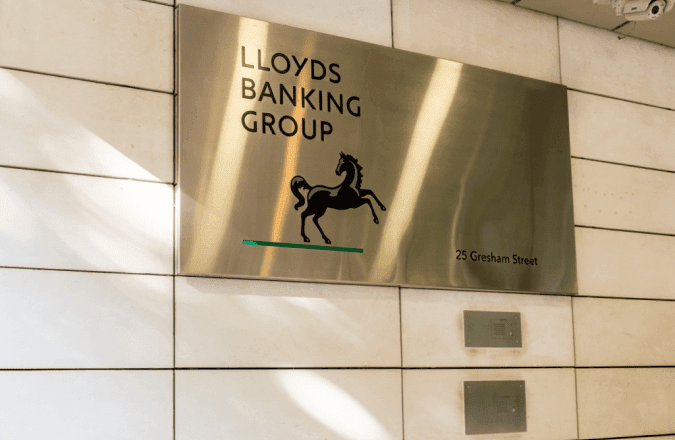Lloyds Banking Group shares: a complete guide

Learn all about Lloyds Banking Group shares, with information on the company’s history and share price journey, its share trading hours, and how to trade Lloyds share CFDs with Capital.com.
What is Lloyds?
Tracing its origins back to 1765, Lloyds Banking Group is one of the biggest banking and financial services institutions in the UK. As an expansive retail and commercial operation, it’s known as one of the ‘Big Four’ UK banks, and runs branches across England and Wales. Lloyds offers a wide range of financial products and services, including personal banking, mortgages, loans, insurance, and investment services.
Lloyds banking group is listed and traded on the London Stock Exchange under the ticker symbol LLOY and on the New York Stock Exchange under the ticker symbol LYG. Lloyds is one of the largest constituents of the UK 100 index. In the 2023 fiscal year, the company’s revenue amounted to £18.3bn.
What is Lloyds’s share price history?
Lloyds’s share price history has seen significant fluctuations over a period of decades. A key bullish period for the bank was during the 1990s, during a period of economic expansion, high interest rates and low inflation, supporting growth in the general banking sector.
Also, ongoing financial deregulation meant that banks such as Lloyds could expand their product offerings, enter new markets and pursue growth opportunities with more freedom. For example, Lloyds’ merger with Cheltenham and Gloucester Building Society allowed it to strengthen its position in the mortgage markets. Attractive dividends also increased appeal for market participants, and at its peak the Lloyds share price moved above £600.
However, around 2000 the fortunes changed for UK banking, with the bursting of the UK dot-com bubble, a generalised economic slowdown amid geopolitical uncertainties, and increased regulation, meant the share price gains achieved in the previous decades were reversed.
The mid 2000s marked a spell of economic recovery along with a stable interest-rate environment that contributed to a revenue growth, reflected in steady share price gains. However, the financial crisis of 2008, influenced to a large extent by the collapse of the US subprime mortgage market, had a devastating impact on the price of Lloyds shares, and in the years since, the stock has been trading in a range of £40-£50.
*Lloyds stock price data from Macrotrends. Correct as of 27 March 2024. Historical price data is inclusive of the effect of stock splits.
Past performance is not a reliable indicator of future results.
What factors might affect the Lloyds live share price?
Lloyds’s share price can be impacted by a range of key fundamental events that can impact its many divisions in diverse ways. Here are a few of the main factors that traders should watch out for.
-
Earnings reports and general financial performance: quarterly earnings reports are an important way for market participants to understand how Lloyds is tracking in terms of sales, profits, and earnings per share. If results are different to analysts’ expectations, the share price may move accordingly. Other financial indicators of performance to look out for in the banking sector include loan provisions, loan portfolio composition and return on equity.
-
Macroeconomic conditions: economic indicators such as interest rates, inflation rates, GDP growth, and unemployment rates can significantly affect Lloyds Banking Group's performance. For example, changes in interest rates by the Bank of England can impact the bank's net interest margin and profitability. Meanwhile, global economic downturns, such as the 2008 financial crisis, can have an outsized effect on the banking sector and associated share prices. Checking out our market analysis can improve your understanding of such fundamental drivers.
-
Strategic initiatives: measures such as cost cutting, expansion plans, new services, and digital transformation can all impact the bank’s strategy, profitability and investor confidence. While strategy can be driven by factors such as competitor performance and consumer consumption patterns, regulatory conditions such as changes in capital requirements, stress test results, and compliance regulations can also influence Lloyds’ business decisions – so it’s worth being informed of these developments.
-
Legal issues: like in other sectors, banks may be involved in legal disputes, and fines related to compliance issues, misconduct, or customer complaints can negatively impact Lloyds’ reputation and financial performance, leading to stock price declines.
What are Lloyds’s stock trading hours?
Lloyds’s stock trading hours are Monday to Friday from 8:00am to 4:30pm (UK time) in accordance with the standard hours of the London Stock Exchange.
If you choose to trade CFDs, you can follow the Lloyds stock performance live in British pounds with the comprehensive Lloyds share price chart.
Monitoring the company’s activity can help you to keep an eye out for any key fundamental or technical events that may affect short-term movements in the Lloyds share value.
How to trade Lloyds shares with CFDs
If you want to take a position on Lloyds shares, you have two options. First, you can buy physical shares in the company through the exchange on which it’s listed. In this case, investing in Lloyds stocks means you will own a share, or shares, in the company. This can be considered a long-term investment, as you’re hoping for the price to rise over time.
Alternatively, you can trade a derivative product such as a contract for difference (CFD) on the underlying Lloyds stock market price, and speculate on its price movements without actually owning the asset. A CFD is a financial contract, typically between a broker and a trader, where one party agrees to pay the other the difference in the value of a security, between the opening and closing of the trade.
Unlike physical share ownership, you can either hold a long position (speculating that the price will rise) or a short position (speculating that the price will fall). This is considered a short-term investment or trade, as CFDs tend to be used within shorter timeframes.
Another key difference between buying physical Lloyds shares and trading through a derivative is the leverage that can be employed with the latter. CFDs are traded on margin, which means that a trader can get exposure to larger positions with a relatively small outlay. This means that both your profits and losses are amplified, making leveraged trading risky. You can learn how to trade shares in our comprehensive guide to shares trading.
To trade Lloyds stock CFDs with us, just sign up for a Capital.com account, and once you’re verified, you can use our advanced web platform or download our intuitive yet easy-to-use app. It’ll take just a few minutes to get started and access the world’s most-traded markets.
Why trade Lloyds CFDs with Capital.com?
Trading CFDs with Capital.com means you’ll enjoy an intuitive, supremely easy-to-use platform, 24/7 support, fair and transparent pricing, along with award-winning education to help build your experience in the markets.* You can seamlessly integrate our smart platform with elite third-party software TradingView and MT4, and refine your strategies with our risk-free demo.
*Awarded best-in-class for education at ForexBrokers.com’s 2024 Annual Awards
FAQs
How much are Lloyds shares worth?
As with any asset, the Lloyds share price is dynamic and liable to change at any time. If you’re trading this stock, it’s important to check the Lloyds chart frequently to keep on top of price movements, as well as retain a strong understanding of the fundamental and technical influences that can cause the price to shift.
How can I invest in Lloyds?
If you want to invest in Lloyds, you can buy and own the physical share, for example through a stockbroker, at a price you think you can profit on in time. Alternatively, trading a derivative, for example through a CFD, can give you leveraged exposure to the underlying price without ownership. However, leverage means that both your profits and losses are amplified, making it risky.
Is Lloyds a good stock to buy right now?
Whether Lloyds is a good stock to buy is dependent on market conditions and the individual judgement of traders. On a technical level, you might consider technical indicators such as the RSI or MACD to identify potential support and resistance. From a fundamental standpoint, a knowledge of vaccine development news, the standing of competitors, earnings release timings, and the regulatory landscape are all key factors that could influence your buy or sell decisions.
Visit our other complete guides

How to trade Sainsbury's
